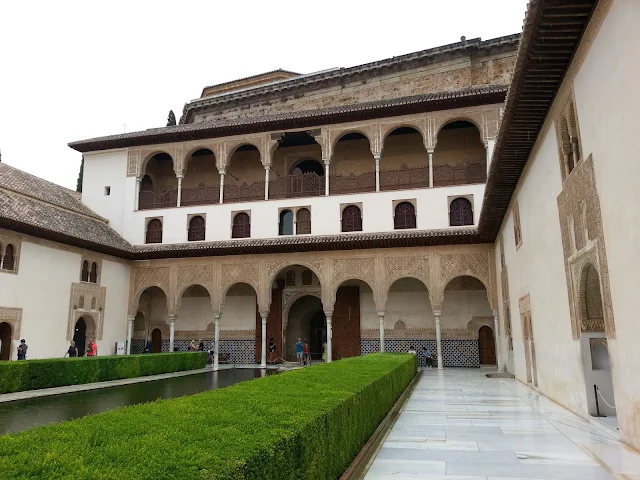Alhambra
Amongst
the world’s greatest treasures, the Alhambra sits in serene silence on a hill
in Granada Spain. I have been in love with it for a long time and a couple of
years ago I spent to as much as I could there. Like a girl I had had a crush on
for a long time, I loved a every moment in her company. Always in my heart.
Granada was the capital of the Moorish kingdom until it was captured by Ferdinande and Isabella in 1492.
On a rocky hill of difficult access, on the banks of the river Darro, protected by the mountains and surrounded by forest, among the oldest districts of the city, the Alhambra rises like an imposing castle of reddish tones in its walls that hide to the Exterior the delicate beauty of its interior.
The
name Alhambra comes from Arabic meaning "red or crimson castle",
perhaps due to the hue of the towers and walls that surround the entire hill of
La Sabica which by starlight is silver but by sunlight is transformed into
gold.
However,
there is another more poetic version, evoked by the Moslem analysts who speak
of the construction of the Alhambra fortress "by the light of
torches", the reflections of which gave the walls their particular
coloration. Created originally for military purposes, the Alhambra was an
"alcazaba" (fortress), an "alcázar" (palace)
and a small "medina" (city), all in one. This triple character
helps to explain many distinctive features of the monument.
The
first kings of Granada, the Zirites, had their castles and palaces on the hill
of the Albaicin, and nothing remains of them. The Nasrites were probably the
emirs who built the Alhambra, starting in 1238.
The founder of the dynasty, Muhammed Al-Ahmar, began with the restoration of the old fortress. His work was completed by his son Muhammed II, whose immediate successors continued with the repairs. The construction of the palaces (called Casa Real Vieja, "old Royal House or Palace") dates back to the 14th century and is the work of two great kings: Yusuf I and Muhammed V. To the first we owe, among others, the "Cuarto de Comares" (Chamber of Comares), the "Puerta de la Justicia" (Gate of Justice), the Baths and some towers. His son, Muhammed V, completed the beautification of the palaces with the "Cuarto de los Leones" (Chamber of the Lions), as well as other rooms and fortifications.
The history of the Alhambra is linked to the geographical location where it is located, Granada;
Designed as a military zone at the beginning, the Alhambra became the royal residence and court of Granada in the mid-13th century after the establishment of the Nasrid Kingdom and the construction of the first palace by the founding king Mohammed ibn Yusuf Ben Nasr, better known as Alhamar.
The fortress becomes a citadel of high walls and defensive towers, which houses two main areas: the military zone or Alcazaba, barracks of the royal guard, and the medina or palatine city, where the famous Nasrid Palaces and the remains of the houses of nobles and plebeians who lived there. The Palace of Carlos V , (built after the city was seized in 1492 by the Catholic Monarchs) , Is also in the medina.
The monumental complex also has an independent palace in front of the Alhambra, surrounded by orchards and gardens, which was the solace of the Granadine kings, The Generalife .
Designed as a military zone at the beginning, the Alhambra became the royal residence and court of Granada in the mid-13th century after the establishment of the Nasrid Kingdom and the construction of the first palace by the founding king Mohammed ibn Yusuf Ben Nasr, better known as Alhamar.
There
is no reference to the Alhambra as a residence of kings until the 13th century,
although fortification has existed since the 9th century. The first kings of
Granada, the Zirtians, had their castles and palaces in the hills of Albaicin,
and nothing remains of them. The monarchs Ziries were in all probability the
emirs who built the Alhambra, beginning in 1238.
The
founder of the dynasty, Muhammed Al-Ahmar, began with the restoration of the
old fort. His work was completed by his son Muhammed II, whose immediate
successors continued the repairs. The construction of the palaces (called Casa
Real Vieja) dates back to the 14th century and is the work of two great kings:
Yusuf I and Muhammed V. The first is awarded, among others, the Fourth Comares,
the Door of Justice , The Baths and some towers. His son, Muhammed V, completed
the beautification of the palaces with the Hall of Lions, in addition to other
rooms and fortifications.
The
Alhambra became a Christian court in 1492 when the Catholic Monarchs conquered
Granada. Later, several structures were built to house prominent citizens,
military barracks, a Church and a Franciscan Monastery. (Sources various)
 |
Fuente de los Leones (Fountain of the Lions) in the
centre of the Patio de los Leones (Court of the Lions), one of the principal
courts at the Alhambra, Granada, Spain.
The Patio de la Acequia at the Generalife, the summer
palace of the Moorish sultans, in Granada, Spain.
























Comments